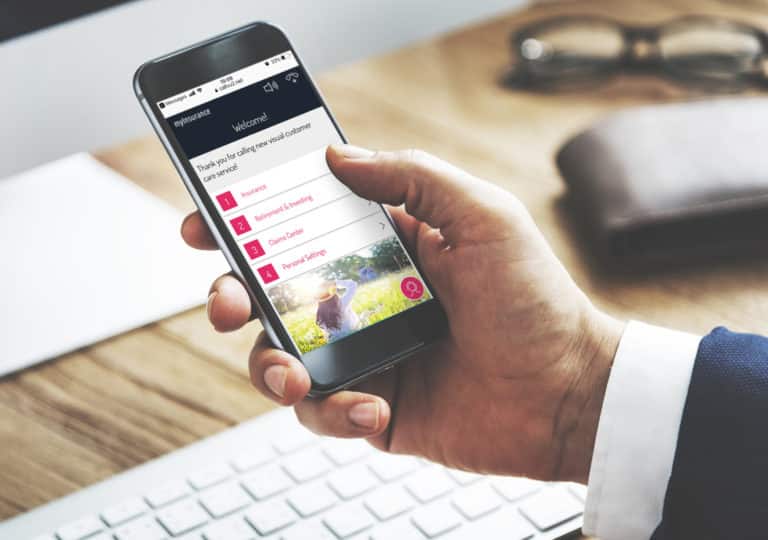Great visual IVR applications are the keystone to any comprehensive call diversion and deflection strategy. The stronger you make them, the more people will be satisfied and choose lower-cost digital self-service channels. This reduces your support costs and CSAT scores. Here are nine principles to remember as your architect and build the best visual IVR apps.
Make it simple. Then simplify it.
The key to creating the best visual IVR apps is making them the easiest way for a customer to complete an action. Any steps in the process that create customer friction points may lead to process abandonment – the person who initially chose a self-service path with call your support line again, and they’ll be angry this time. Or perhaps they’ll give up on you entirely and move their business to a competitor.
Things don’t have to be “broken” to create friction. If steps are confusing or unclear, you foster consumer frustration and inconvenience. These forces sour customers to both this app and trying other digital self-service experiences. One valuable strategy to help here is to build experiences that perform one task versus several. This will help you streamline the flow and steps, enhancing completion rates and overall customer satisfaction.
Deliver your brand design elements
Every customer experience your brand produces needs to look professional and consistent. Your brand design elements were created to communicate your brand values in commercials, webpages, store design, and more. They should do the same as part of your digital self-service apps. This also smooths the transition from voice IVR to visual IVR.
Most brands find that more minimalist brand expressions contribute to the best visual IVR apps. Try to define a look consistent with other brand materials but doesn’t distract from the utility. Simple works best – especially on small screens.
Reduce choice options whenever possible
Most people prefer to make choices from a relatively limited number of options. If you can simplify any decisions a customer needs to make, they will find your visual IVR app more straightforward and satisfying.
This tip is why we recommend building apps focused on a single task, like checking balance. The simpler you can make each user experience, the better. Apps with just a few potential paths drive the best completion rates. Along the same lines, connecting a customer to your account management page or other complicated environment/experience is seldom a good idea. Streamlined, purpose-built apps drive the best visual IVR app completion rates and customer satisfaction.
Provide help in places people may get stuck
Sometimes, customers can be confused by terminology or why your company must collect certain information to resolve customer issues. Having available explanations accessible via click or rollover can help get customers through steps that might otherwise become bottlenecks.
Naturally, this requires a balancing act so that the content in the experience contributes to a greater completion rate.
Never ask customers for info you already have
Many companies haven’t yet fully integrated data across their infrastructure and systems. As a result, they cannot always access a complete set of customer information from a particular touchpoint. Instead, they may need to ask customers to provide information that the company already has in other systems.
For customers, these are irksome tasks. In the context of digital self-service experiences, needing to reinput data can drive customers to abandon processes. Wherever possible, a digital self-service experience should be integrated with all the systems necessary to deliver a positive brand experience without requiring users to re-enter data.
Personalize the experience
Once a customer’s identity has been established in a digital self-service experience, it makes sense to personalize the user’s experience so that each customer feels their unique needs have been met.
Using the person’s name in the experience is part of this personalization effort. But real personalization means taking steps to customize the content and information to the characteristics and preferences of the customer discernable from their customer data and likely “next” needs.
Consider “next-step” Visual IVR experience options
Once a customer completes a process, it makes sense to consider what else the user might want to do. If a customer were speaking with an agent, their request wouldn’t be limited to a single question, so it makes sense to provide logical options at the conclusion of experiences.
For example, consider an app for checking a balance. As a final step, it’s logical to think, ‘what would a user want to do AFTER they learned their balance?’ Logic suggests that offering links to other simple micro-apps for making a payment or disputing a transaction might be prudent.
Don’t block callers from speaking with an agent
You shouldn’t penalize users if they try to solve their own problems but get stuck. As CX leaders, our goal is satisfied customers, and visual IVR allows us to address customer needs in ways that can be more satisfying and less expensive. Best practices are to give customers the option of visual IVR and the opportunity to return to the call center queue if they get stuck.
As you architect digital self-service experiences, recognize that some customers may struggle with steps in your process. A way to return to the contact center queue may be necessary, especially for more complex or involved experiences.
Test experiences before and after launch
Visual IVR experiences should be evaluated based on the extent to which customers choose and complete them and are satisfied with the experiences. It’s essential to test a visual IVR experience before launching it to ensure it provides a positive customer experience.
But testing should not stop at launch. Making ongoing adjustments to determine their impact on completion rates and customer satisfaction should be an ongoing part of any visual IVR go-to-market plan. This ensures you deliver the best customer experience possible and recognizes that customer preferences constantly evolve. When you can find flexible ways to develop and update experiences, you can keep your visual IVR experiences current and relevant for customers.
Learn more about building the best visual IVR apps
To learn more about visual IVR, visit the FICX homepage, request a demo, or explore some of the additional content we have available on the topic. Many other posts on visual IVR and call diversion/deflection are highlighted below.





